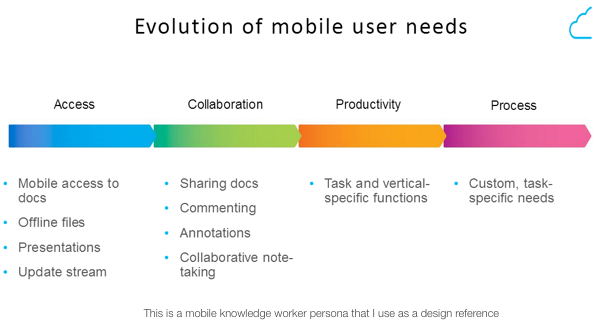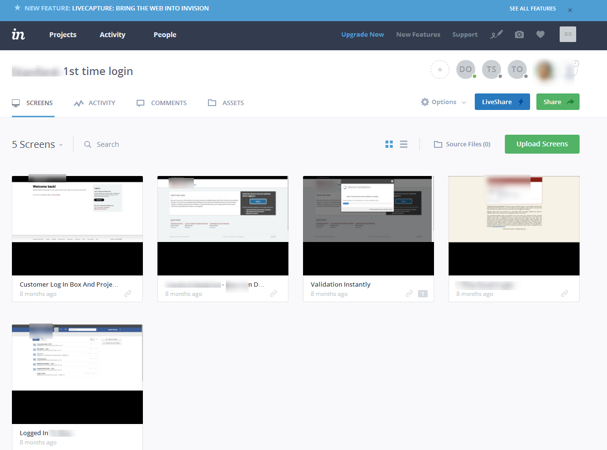
Document and content collaboration all comes down to the individuals that interact with it—the users, the people. They are defined by consumer experience expectations and mobility as a style of working, and, because of that, the collaboration and content industries are seeing an increase in focus on building a quality user experience first. Compare Yammer to Facebook, and you see what I mean. To that end, quality and empathetic user experiences will help you create better content and collaboration experience, though that is sometimes at the trade-off of traditional enterprise features or ability to customize that experience.
Given that, asking "So, how do you do it?" is an entirely valid question. Collaboration is something you DO, and in collaboration with numerous customers, partners and colleagues, here are my top five ideas on how to think about user experience when dealing with content and collaboration.
1. Create personas
Do you know who is consuming what you create? Is it an IT manager? Your end customer? Do you truly understand how they currently interact with content today? Create a real background for the personas that you target in order to build an experience for them. For example, "Manjit is a former CIO who manages a portfolio of 30 cloud applications and works across his phone, iPad and laptop and collaborates with vendors and partners and cares deeply about security. Uses Yammer, Box and Exchange" is better than "CIO."

Keep it more on the side of "Sim who lives in my house in The Sims" and not like "Her."
You get the idea. And speaking of ideas...
2. Borrow good ideas
Like a scene out of National Treasure, successful ideas leave clues. Look at how your users currently interact with similar technologies. For example, if you are trying to be a Uber for _____, let's say Uber for pizza delivery, then you should test out and learn from other leaders in the transportation or delivery categories. In collaboration, everything is about helping people work together. Work, together. Yeah? Cool. Don't hesitate to find inspiration and be able to incorporate ideas into building an experience that works the way people have become accustomed.
3. Build a MVP, and ship it
Ship often, ship always. But before that, build just enough to see if your ideas stand up to real people using them. A MVP doesn't even need to be feature complete; you can fake things with mock-ups and prototyping tools. Using a screenshot editing tool and hot-spots, can you A/B test flows and see how real people interact with your applications and content? It's very cool to be able to build the basics of what you need and move things around manually, if needed, to test things. For example, if part of your collaboration workflow involves looking up data in another system, you would do that step manually and focus your efforts on validation of your ideas.

This is a sample login flow that I was testing |
4. Eat and share your dog food
DELICIOUS. There is likely a more elegant way of describing the process of eating your own chow, but for the purposes of simplicity, I'll hold that dogfooding means you use your own products in the way your end users do. In a web content management product, for example, can you interact with libraries stored with a cloud storage provider, or do you have to work off their integrated asset management? You need to test and understand that process. If you aren't willing to interact with a process in a meaningful way, it's not fair to ask end users to either. You are your ultimate customer, or you should be out of the collaboration business entirely.
5. Collect meaningful feedback
Let's assume that you understand your users and what problems they want to solve (for sharing, working across teams, collaborating on content) and you have built and tested a MVP and are using the latest version yourself for hands-on testing. Great! Now what? You gotta be prepared! Not scared. Not ensnared. Prepared. The best way to do that is by collecting meaningful feedback on your ideas and then incorporating that feedback in an iterative manner. Specifically on the topic of feedback, I'm fond of doing small group discussions and user interviews to gather qualitative feedback, and I use surveys to collect quantitative feedback and to analyze trends. For example, after I launch a new feature, I'll pull a small group of users into a meeting to discuss their impressions, then follow that up with a survey to a larger group of users.
The last thing to remember is this—collaboration is something that is more fun with others. Go out and talk to your team, your customers and, most importantly, the people who you collaborate and share content.
Follow Mr. O'Leary on Twitter @danieloleary.










